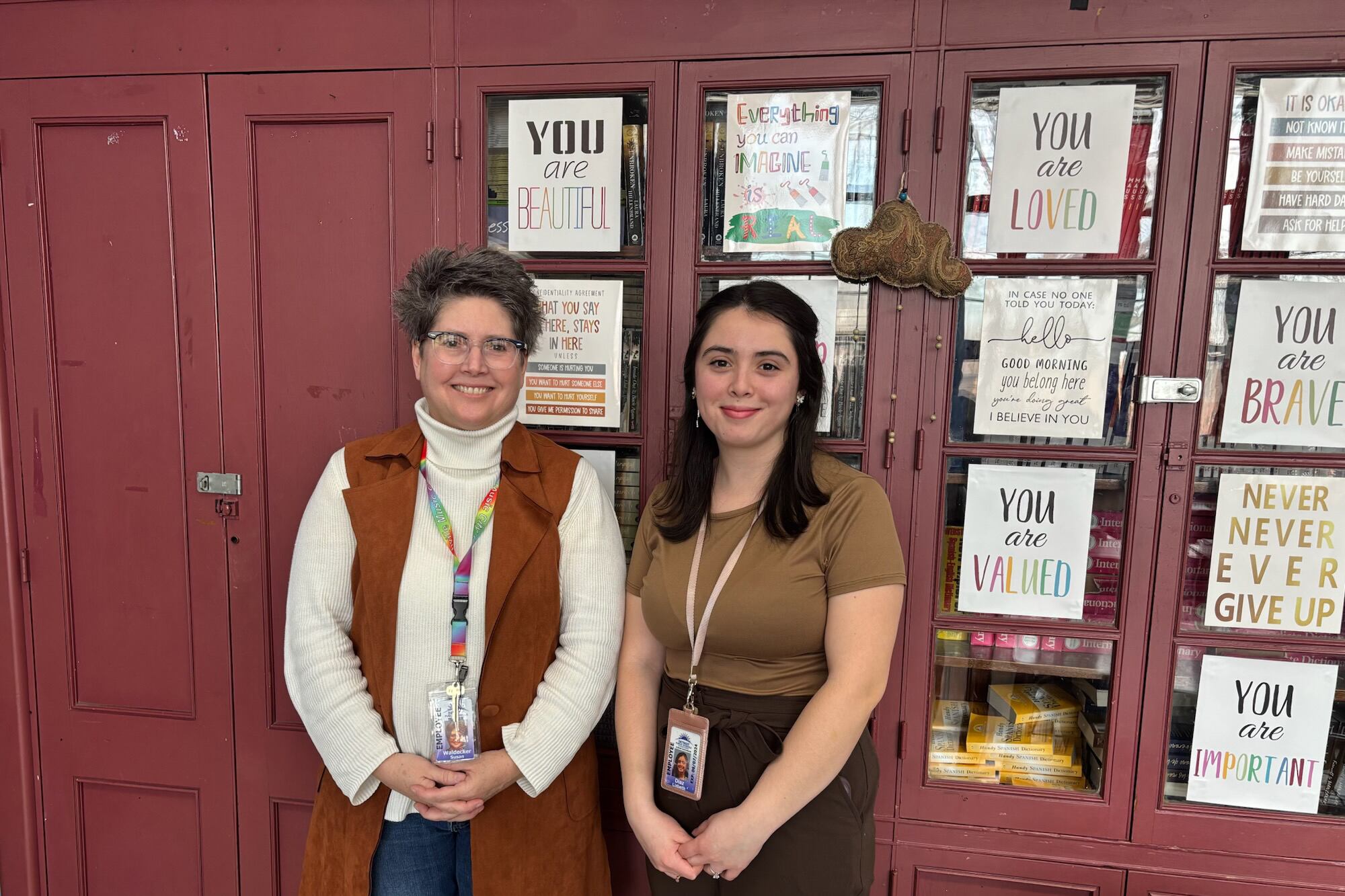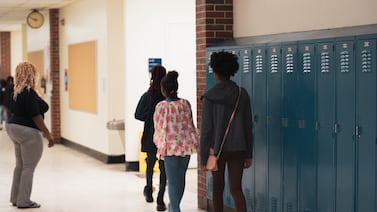Sign up for Chalkbeat Detroit’s free newsletter to keep up with the city’s public school system and Michigan education policy.
In her 31-year career as an educator, Detroit Public Schools Community District teacher Susan Waldecker held teaching gigs throughout Michigan and beyond.
Now, she’s taking on a new role as a student.
The 57-year-old teacher at the Neinas Dual Language Learning Academy in Southwest Detroit is enrolled in Talent Together. The statewide initiative trains individuals to become certified teachers, offers pathways for those without bachelor’s degrees, and it aids certified teachers — like Waldecker — in broadening the areas they are eligible to teach.
Waldecker is taking online courses through Central Michigan University to earn a certification in English as a second language. She gains hands-on training at Neinas, which has a large Hispanic student population. Waldecker said she had several migrant students in her classes last year and struggled to communicate with them.
“That [the ESL certification] will be added to my teaching certificate and I’ll have more knowledge and expertise in teaching kids who don’t speak English,” she said. “I’m already using a lot of what I’m learning in my class. The difference between this year and last year is night and day. I just feel better prepared.”
Talent Together works with 56 intermediate school districts and 18 colleges to match participants with accredited and approved Michigan educator preparation programs, paying full tuition and fees.
The effort welcomed 800 fellows into its first cohort in 2023, with another 550 joining the second cohort last fall. Overall, there are about 1,100 aspiring teachers in the pipeline. The program achieved a 94% candidate retention rate in its first year, meaning most educators who started the training continued it the next year or graduated, said Jack Elsey, CEO of Michigan Educator Workforce Initiative, an education nonprofit helping lead Talent Together.
While taking classes, prospective teachers take part in a one-year apprenticeship and receive mentorship and support from established educators. Target candidates for the program are community members interested in working in a school setting, paraprofessionals, substitute teachers, and current teachers.
As schools in Michigan and across the country attempt to find solutions to solve the teacher shortage, “grow your own” pipeline programs have begun popping up in recent years. All 50 states now have some kind of alternative teacher certification program, according to a report from think tank New America.
Along with Talent Together, other programs across the state include Teach for America Detroit, which has since expanded into TeachMichigan. On the local level, DPSCD has its own alternative teacher certification program On the Rise Academy, along with New Paradigm for Education, which manages the Detroit Edison Public School Academy network of charter schools.
State officials are beginning to invest in “grow your own” programs, with lawmakers approving $175 million in 2022 to train existing school personnel or community members to become teachers.
The state also invested in Talent Together. In recent years, the program, along with the Michigan Educator Workforce Initiative, have received $101.4 million in taxpayer funds.
Elsey, whose organization is dedicated to eliminating the state’s educator shortage, said programs like Talent Together are the future in terms of recruiting and training teachers.
“What we’re learning is the current modes of staffing teachers are not diverse enough and they have a lower success rate than we would like,” he said. “And most, if not all, the Talent Together participants are not people who would have gone to a traditional educator preparation program. These are new people we’ve identified because current educator preparation programs were really not accessible to them, whether that’s for cost reasons or logistical reasons or others.”
A possible solution to Michigan’s teacher shortage
For many Michigan districts, a teacher shortage has been brewing for years, beginning with the Great Recession, which left many schools reeling financially and caused widespread job uncertainty for staff. Meanwhile, fewer people were choosing the profession to begin with. In 2014-15, there were 14,749 people enrolled in teacher preparation programs. But numbers are beginning to rebound, with 16,260 people enrolled in 2022-23.
Pay and an aging workforce are also factors. Beginning teachers average $37,320 annually, according to the Michigan Education Association, and it can take years for a new teacher to reach the top of the pay scale. Michigan teachers also tend to be older — 62% of teachers in the state are over the age of 40.
On top of those challenges, school districts with the highest concentrations of poverty in the state struggle significantly more than wealthier school systems to attract and retain experienced teachers.
Elsey said after he founded the Michigan Educator Workforce Initiative in 2022, he began talking to educators across the state about possible solutions to the teacher shortage.
“We spent the summer of 2022 really ideating, talking to some national experts, just sort of figuring out what role could a public/private partnership between districts and a nonprofit play in bringing a solution to Michigan for the teacher shortage, and ultimately, that became Talent Together,” he said.
Elsey said in the first year, a small group of K-12 superintendents worked closely with the program and spread the word to local school districts. Now, participating districts have a formal consortium with a board that meets quarterly.
In November 2022, Talent Together released a Request For Proposal (RFP) for colleges and universities statewide, inviting every educator preparation program in the state, Elsey said. Some of the colleges that are involved in the program include Central Michigan, Davenport University, Concordia University Ann Arbor, and the University of Michigan-Flint.
In addition to ushering in the next generation of teachers, Talent Together is dedicated to closing the gap between white teachers and teachers of color. According to a 2021 report from the Michigan State University group Education Policy Innovation Collaborative, the proportion of Black teachers in Michigan slightly increased from 5% to 5.8% over the past decade — an addition of 469 Black teachers. The proportion of Hispanic teachers in Michigan increased from 1.0% to 1.4%, equaling 295 teachers.
“Currently 31% of Talent Together participants identify as [Black, Indigenous, and People of Color],” Elsey said. “It was a little over 20% in cohort one and it’s about 42% in cohort two.”
Ultimately, Elsey said the issue isn’t that people don’t want to become teachers, it’s that they’re looking for a way to make the process faster and more flexible than a traditional teacher’s program.
“We have to make it feasible for someone who is, say, a paraeducator or a tutor, but doesn’t have the ability to quit their job to enroll in college or doesn’t have the money to pay for college,” he said.
Opening doors for the next generation of students
Along with Waldecker, Neinas staff member Lizbeth Diaz enrolled in Talent Together last fall. The native Detroiter is an academic interventionist, working directly with teachers to help students with their reading and math skills.
Diaz, 27, is taking the steps to become a teacher herself, as she works to obtain her certification in online classes through Concordia University.
Some of the things Diaz has been learning include classroom management, creating positive relationships with students and best practices to teach students how to read, including English language learners.
“Right now, we’re taking the science and math course but it’s broad enough where one week was about physical education in the classroom,” she said. “So, we’re learning a lot of diverse topics that support the whole child development.”
Meanwhile, Waldecker is learning how to use the Sheltered Instruction Observation Protocol (SIOP) Model, which has proven effective in addressing the academic needs of multilingual learners. In her spare time, Waldecker is also taking Spanish classes to better communicate with her students.
“We’re not just reading a book together, I’m also intentional about what language skills I’m focusing on in that lesson,” she said. “The bottom line is I’m learning how to better include my students who don’t speak English, including them in the lesson and holding them accountable for learning the same things that the other kids are learning, and that’s been a game changer for me this year.”
The two said juggling a work/life balance has been challenging since joining Talent Together, especially for Diaz, who has a toddler at home. But Waldecker and Diaz said it’s worth it to gain new skills and receive their certifications.
Diaz hopes to eventually become a math or science teacher, while Waldecker wants to transition into a position teaching English language learners. Both want to stay at Neinas.
Diaz has a personal connection to the school as a former student and wants to give back to the students who are at Neinas today.
“I’ve always felt that education needed to be better,” she said. “I am a product of DPS, and when I got to college and I was trying to keep up with classes, I wasn’t able to, so I wasn’t measuring up to what my peers were doing in college. Why is there such a disparity in our education? And that’s always kind of pushed me to want to pursue this.”
Bridge Michigan reporter Isabel Lohman and Chalkbeat Detroit Bureau Chief Lori Higgins contributed to this story.






